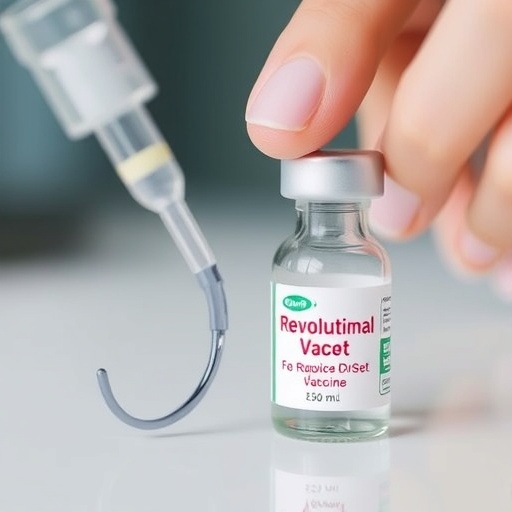In a groundbreaking study, researchers at CU Boulder have made significant strides toward revolutionizing rabies vaccination, a critical public health challenge that leads to about 60,000 deaths annually around the globe. Although rabies is largely under control in industrialized nations, it remains a persistent threat in developing regions, particularly in rural parts of Asia and Africa. The innovative research outlined in a recent publication emphasizes creating human rabies vaccines that are not only temperature-stable but also designed for single-dose delivery. This advancement could drastically increase access to vaccination in under-resourced areas worldwide.
Existing rabies vaccinations require stringent cold storage and multiple doses over time. Traditional formulations must sometimes be kept at freezing temperatures as low as minus 76 degrees Fahrenheit to maintain their efficacy. Without consistent refrigeration, the proteins in vaccines can degrade, rendering them ineffective—much like milk that has soured after being left unrefrigerated. This creates substantial barriers, especially in rural communities where electricity is irregular or non-existent, hindering vaccination efforts.
Ted Randolph, the lead author of the study and a professor in CU Boulder’s Department of Chemical and Biological Engineering, highlights the limitations posed by current vaccine technologies. The challenge is not just about maintaining temperature control; it’s also about ensuring that patients receive the full course of doses required for effective immunization. Access to medical services in rural areas is often limited, meaning that people may miss out on necessary follow-up visits. This new research addresses these critical issues by pioneering a formulation that can be stored without refrigeration and delivered in a single shot.
The method described in the research entails the creation of a new type of vaccine delivered through a candy-like microparticle. This innovative vaccine encapsulates inactivated rabies viruses within a sugar matrix, preserving the integrity of the viral proteins which are crucial for eliciting an immune response. The research team has leveraged advanced engineering techniques, including a process known as atomic layer deposition, to add a protective sapphire coating. This nanoscopic layer serves as an additional safeguard, dissolving slowly in the body to release the vaccine in controlled doses over time.
One of the paramount advantages of these sapphire-coated, single-administration vaccines is their ability to remain viable and effective at elevated temperatures. Experiments with laboratory mice have demonstrated that even when these vaccines were stored in harsh conditions—exposed to temperatures up to 104 degrees Fahrenheit for three months—the immune responses elicited were not only robust but superior to traditional multiple-dose vaccines. This groundbreaking finding signifies a leap forward in how we might approach vaccination protocols in regions where logistical challenges complicate health care delivery.
From a manufacturing perspective, Randolph’s team has developed a straightforward spraying technique that creates these microparticles by transforming sugar solutions into a fine mist that dries into a functional powder. This methodology allows for economical production and bulk distribution of vaccines while considerably extending their shelf life. The result is a stable, dry powder capable of being deployed in areas severely lacking in medical infrastructure, democratizing access to rabies vaccines around the world.
The significance of this research extends beyond just rabies vaccination. The same temperature-stable technology holds promise for developing additional vaccines for other diseases such as HPV and HIV, making it a versatile platform for future immunizations. This broader application emphasizes the potential impact of innovative science on public health, and it may soon pave the way for significant improvements in vaccination campaigns across the globe.
Moreover, the study highlights the collaborative efforts of both engineering and biological sciences. The incorporation of various academic disciplines illustrates how cross-pollination of ideas can culminate in groundbreaking advancements. Scientists and engineers have come together to examine not just the biological effectiveness of vaccines but also the physical logistics of their distribution, storage, and administration.
While these new vaccines have shown tremendous promise in preclinical studies, human clinical trials are still in the development phase and will take a few years to commence. Nonetheless, the preliminary data has invigorated excitement within the scientific community. The researchers remain optimistic that these new vaccines will contribute to public health efforts and potentially save countless lives.
In conclusion, the CU Boulder research team has laid the groundwork for a new era in vaccine development that could significantly alter the landscape of infectious disease prevention. Their focus on overcoming the traditional barriers associated with vaccine storage and administration speaks directly to the issues of accessibility and equity in health care. In a world where vaccine-preventable diseases still take a toll on vulnerable populations, this innovative solution may well be a game changer in the ongoing battle against rabies and similar infectious diseases.
Subject of Research: Development of temperature-stable single-dose rabies vaccines
Article Title: Superior immune responses from thermostable, single-administration rabies vaccines prepared using atomic layer deposition
News Publication Date: 2-Aug-2025
Web References: https://jpharmsci.org/article/S0022-3549(25)00388-0/abstract
References: None
Image Credits: Ted Randolph/University of Colorado Boulder
Keywords
Applied sciences and engineering, Biomedical engineering, Biotechnology, Biochemical engineering




